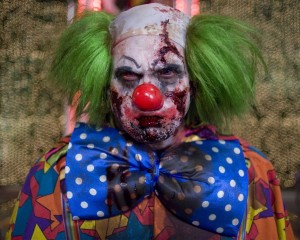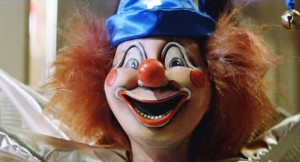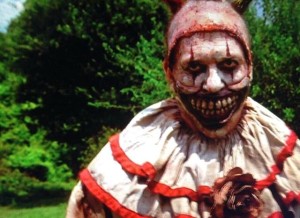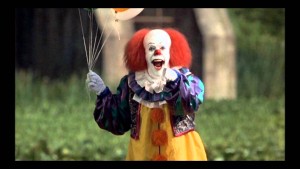Clowns! You hate ’em, we hate ’em. There may be nothing as universally terrifying as the clown, and yet, a proper clown horror film is a tough nut to crack.
So, before we launch into the 5 best clown films, let’s first pay tribute to the 5 scariest clowns to ever grace the screen:
5. Zombieland Clown (Derek Graf)
4. Captain Spalding (House of 1000 Corpses/Devil’s Rejects) (Sid Haig)
3. Poltergeist Clown
2. Twisty the Clown (American Horror Story: Freakshow) (John Carrol Lynch)
1. Pennywise (It) (Tim Curry)
On to the main event! Here are the five clowniest horror movies!
5. Clownhouse (1989)
There are several fascinating pieces of information concerning the derivative yet uniquely weird Clownhouse. These range from odd to awful.
1) The Sundance Film Festival somehow found this film – this one, Clownhouse, the movie about 3 escaped mental patients who dress as clowns, break into a house where three brothers are home alone on Halloween night, and commence to terrify and slaughter them – worthy of a nomination for Best Drama. If you haven’t seen this film, you might not quite recognize how profoundly insane that is.
2) The great and underappreciated Sam Rockwell made his feature debut as the dickhead oldest brother in this movie. The clowns themselves – Cheezo, Bippo, and Dippo – are genuinely scary and garishly fascinating, but outside of them, only Rockwell can act. At all.
3) Writer/director Victor Salva would go on to create the Jeepers Creepers franchise. But first he would serve 15 months of a 3-year state prison sentence for molesting the 12-year-old lead actor in this film, Nathan Forrest Winters.
Basically, there are four really solid clown horror movies in the world and about 200 truly bad ones. Clownhouse does set itself above the rest of the muck with these disturbing points of interest.
https://www.youtube.com/watch?v=xi0ci-GjLx4
4. Clown (2014)
Sympathetic, surprising, and often very uncomfortable, Jon Watt’s 2014 horror flick, though far from perfect, does an excellent job of morphing that lovable party favorite into the red-nosed freak from your nightmares.
Kent (a pitiful Andy Powers) stumbles across a vintage clown outfit in an estate property he’s fitting for resale. Perfect timing – his son’s birthday party is in an hour. What a surprise this will be, unless the suit is cursed in some way and will slowly turn Kent into a child-eating demon.
It does! Hooray!!!
A weird-as-ever supporting turn from Peter Stormare helps the film overcome other acting weaknesses, but Watts gets credit for taking the horror places you might not expect, and for squeezing as much sympathy as possible before that last swing of the ax.
3. The Man Who Laughs (1928)
The German Expressionist director Paul Leni (Waxworks, The Cat and the Canary) worked with J. Grubb Alexander’s adaptation of Victor Hugo’s novel to cast a macabre spell with this film – one of our very favorites.
A nobleman offends the king, who kills the nobleman (iron maiden!) and has his son, Gwynplaine, disfigured by a surgeon so he can spend his life laughing at his fool of a father. The boy is tossed out, wandering in the snow. He finds a blind baby girl, and the two are saved by a traveling carny.
As is Hugo’s way, goodness is found in the tormented and hideous while the gorgeous society show themselves to be the true beasts. The film looks gloomily gorgeous, and in the hands of silent film star Conrad Veidt, Gwynplaine becomes Hugo’s most sympathetic and heartbreaking monster.
2. Stitches (2012)
There are a lot of scary clowns in films, but not that many can carry an entire film. Stitches can.
This Irish import sees a half-assed clown accidentally offed at a 6-year-old’s birthday party, only to return to finish his act when the lad turns 16.
Yes, it is a familiar slasher set up: something happened ten years ago – an accident! It was nobody’s fault! They were only children!! And then, ten years later, a return from the grave timed perfectly with a big bash that lets the grisly menace pick teens off one by one. But co-writer/director Connor McMahon does not simply tread that well-worn path. He makes glorious use of the main difference: his menace is a sketchy, ill-tempered clown.
Dark yet bawdy humor and game performances elevate this one way above teen slasher. Gory, gross, funny and well-acted – it brings to mind some of Peter Jackson’s early work. It’s worth a look.
1. The Last Circus (2010)
Who’s in the mood for something weird?
Unhinged Spanish filmmaker Alex de la Iglesia returns to form with The Last Circus, a breathtakingly bizarre look at a Big Top love triangle set in Franco’s Spain.
Describing the story in much detail would risk giving away too many of the astonishing images. A boy loses his performer father to conscription in Spain’s civil war, and decades later, with Franco’s reign’s end in sight, he follows in pop’s clown-sized footsteps and joins the circus. There he falls for another clown’s woman, and stuff gets nutty.
Like Tarantino, Igelsia pulls together ideas and images from across cinema and blends them into something uniquely his own, crafting a film that’s somewhat familiar, but never, ever predictable.
The Last Circus boasts more than brilliantly wrong-minded direction and stunningly macabre imagery – though of these things it certainly boasts. Within that bloody and perverse chaos are some of the more touching performances to be found onscreen.







